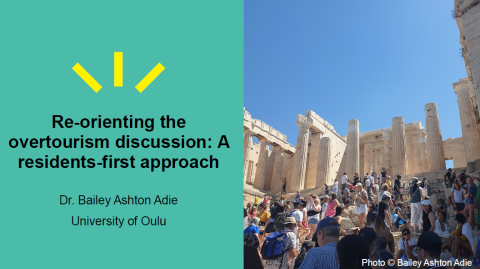Dr. Adie on a Residents-First Approach to Overtourism
We recently welcomed Dr. Bailey Adie, a noted expert from the University of Oulu, for a thought-provoking online session. Dr. Adie guided participants through a fresh approach to tackling overtourism - one that places the needs and well-being of local residents at the forefront of tourism management. The session, structured as a presentation followed by an engaging Q&A and discussion, explored solutions to the challenges of overtourism that have been reshaping many popular destinations worldwide.
A New Perspective on Overtourism: Putting Residents First
The presentation delved into the pervasive issues that overtourism creates, from overcrowding and limited access to local amenities to the cultural and lifestyle shifts residents experience due to high tourist influx. By sharing insights on cities like St. Ives, Kyoto, Venice, and Seoul, Dr. Adie highlighted how these locations have struggled with seasonal tourism peaks that often prioritise visitor enjoyment over community needs.

The Residents-First Model: A Community-Centered Approach
Central to her presentation was the "residents-first" model, a transformative approach to tourism management that advocates for placing local community well-being at the core of tourism planning and development. Instead of focusing exclusively on visitor satisfaction, this model encourages:
- Bottom-up planning, where residents are empowered to participate actively in shaping tourism policy.
- Economic diversification to mitigate dependence on tourism, enhancing economic stability.
- Strategies to manage housing costs and inflation driven by tourism, ensuring that local communities remain liveable and affordable.
Practical Strategies for Sustainable Tourism
Actionable measures that local governments and stakeholders can adopt to balance tourism growth with resident needs, were presented. These include:
- Improving public transportation and infrastructure to accommodate both tourists and residents more effectively.
- Adjusting opening hours of tourist sites to reduce congestion and distribute visitor flow more evenly.
- Incentivizing local businesses to preserve authentic cultural offerings rather than catering solely to tourists.
Final Takeaways: Proactive Planning for a Balanced Future
Dr. Adie emphasised the importance of planning for overtourism before it becomes unmanageable, a perspective that aligns perfectly with the goals of the Tourism in Balance Project. By implementing a residents-first approach, destinations can foster a sustainable tourism environment that enhances quality of life for residents and provides visitors with a more genuine experience. This proactive approach ensures that tourism development remains a positive force, contributing to the long-term health of both local communities and the tourism industry.
Join Us in Future Sessions
This session with Dr. Bailey Adie represents just one of the many expert discussions we’re organising as part of our Project. Stay tuned for more insights from thought leaders and join us in rethinking and reshaping tourism management for a balanced, sustainable future.
